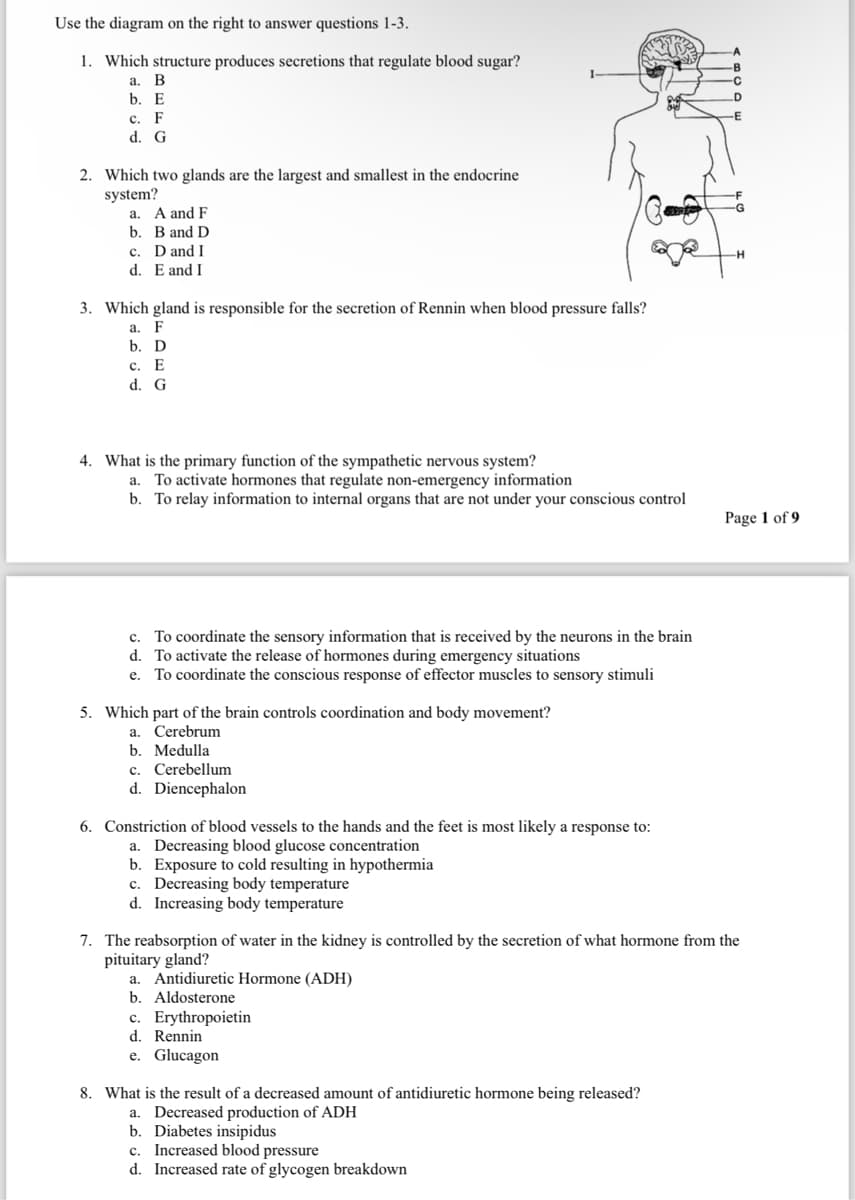Use the diagram on the right to answer questions 1-3. 1. Which structure produces secretions that regulate blood sugar? a. B b. E c. F d. G 2. Which two glands are the largest and smallest in the endocrine system? a. A and F b. B and D c. D and I d. E and I 3. Which gland is responsible for the secretion of Rennin when blood pressure falls? a. F b. D c. E d. G 4. What is the primary function of the sympathetic nervous system? D -H a. To activate hormones that regulate non-emergency information b. To relay information to internal organs that are not under your conscious control Page 1 of 9 c. To coordinate the sensory information that is received by the neurons in the brain d. To activate the release of hormones during emergency situations e. To coordinate the conscious response of effector muscles to sensory stimuli 5. Which part of the brain controls coordination and body movement? a. Cerebrum b. Medulla c. Cerebellum d. Diencephalon 6. Constriction of blood vessels to the hands and the feet is most likely a response to: a. Decreasing blood glucose concentration b. Exposure to cold resulting in hypothermia c. Decreasing body temperature d. Increasing body temperature 7. The reabsorption of water in the kidney is controlled by the secretion of what hormone from the pituitary gland? a. Antidiuretic Hormone (ADH) b. Aldosterone c. Erythropoietin d. Rennin e. Glucagon 8. What is the result of a decreased amount of antidiuretic hormone being released? a. Decreased production of ADH b. Diabetes insipidus c. Increased blood pressure d. Increased rate of glycogen breakdown
Use the diagram on the right to answer questions 1-3. 1. Which structure produces secretions that regulate blood sugar? a. B b. E c. F d. G 2. Which two glands are the largest and smallest in the endocrine system? a. A and F b. B and D c. D and I d. E and I 3. Which gland is responsible for the secretion of Rennin when blood pressure falls? a. F b. D c. E d. G 4. What is the primary function of the sympathetic nervous system? D -H a. To activate hormones that regulate non-emergency information b. To relay information to internal organs that are not under your conscious control Page 1 of 9 c. To coordinate the sensory information that is received by the neurons in the brain d. To activate the release of hormones during emergency situations e. To coordinate the conscious response of effector muscles to sensory stimuli 5. Which part of the brain controls coordination and body movement? a. Cerebrum b. Medulla c. Cerebellum d. Diencephalon 6. Constriction of blood vessels to the hands and the feet is most likely a response to: a. Decreasing blood glucose concentration b. Exposure to cold resulting in hypothermia c. Decreasing body temperature d. Increasing body temperature 7. The reabsorption of water in the kidney is controlled by the secretion of what hormone from the pituitary gland? a. Antidiuretic Hormone (ADH) b. Aldosterone c. Erythropoietin d. Rennin e. Glucagon 8. What is the result of a decreased amount of antidiuretic hormone being released? a. Decreased production of ADH b. Diabetes insipidus c. Increased blood pressure d. Increased rate of glycogen breakdown
Chapter1: Ready, Set, Go
Section: Chapter Questions
Problem 16MC
Related questions
Question
please answer all if possible i need it badly and asap make sure its correct

Transcribed Image Text:Use the diagram on the right to answer questions 1-3.
1. Which structure produces secretions that regulate blood sugar?
a. B
b. E
c. F
d. G
2. Which two glands are the largest and smallest in the endocrine
system?
a. A and F
b. B and D
c. D and I
d. E and I
3. Which gland is responsible for the secretion of Rennin when blood pressure falls?
a. F
b. D
c. E
d. G
4. What is the primary function of the sympathetic nervous system?
D
-H
a. To activate hormones that regulate non-emergency information
b. To relay information to internal organs that are not under your conscious control
Page 1 of 9
c. To coordinate the sensory information that is received by the neurons in the brain
d. To activate the release of hormones during emergency situations
e. To coordinate the conscious response of effector muscles to sensory stimuli
5. Which part of the brain controls coordination and body movement?
a. Cerebrum
b. Medulla
c. Cerebellum
d. Diencephalon
6. Constriction of blood vessels to the hands and the feet is most likely a response to:
a. Decreasing blood glucose concentration
b. Exposure to cold resulting in hypothermia
c. Decreasing body temperature
d. Increasing body temperature
7. The reabsorption of water in the kidney is controlled by the secretion of what hormone from the
pituitary gland?
a. Antidiuretic Hormone (ADH)
b. Aldosterone
c. Erythropoietin
d. Rennin
e. Glucagon
8. What is the result of a decreased amount of antidiuretic hormone being released?
a. Decreased production of ADH
b. Diabetes insipidus
c. Increased blood pressure
d. Increased rate of glycogen breakdown
Expert Solution
This question has been solved!
Explore an expertly crafted, step-by-step solution for a thorough understanding of key concepts.
Step by step
Solved in 2 steps

Recommended textbooks for you



